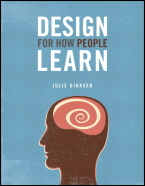Book Review: Design For How People Learn
Design For How People Learn, by Julie Dirksen (ISBN 978-0321768438)

I saw the title for this book roll across my Twitter feed — can't remember from who, sorry — from someone who had a blog and was advocating for other bloggers to check this book out. When I read the abstract for the book, I immediately added it to my reading list.
"Whether it's giving a presentation, writing documentation, or creating a website or blog, we need and want to share our knowledge with other people. But if you've ever fallen asleep over a boring textbook, or fast-forwarded through a tedious e-learning exercise, you know that creating a great learning experience is harder than it seems."
I can think of three types of people who would enjoy this book:
- People who enjoy learning. Like, say, IT people. Or people who enjoy achieving for certifications or designations in their field. The book talks about how we learn and our different types of memory. It would be fascinating to use the information in the book to help shape a self-study program.
- Pre-sales people who are responsible for delivering presentations to customers. Understanding why your audience's minds wander, why it's important to identify and address the different kinds of learning gaps, and how to get (and keep) your audience's attention are just three of the topics the book talks about.
- Bloggers or technical writers. Like pre-sales folks, identifying the different types of learning gaps is relevant to writers, but so is learning about how to create compelling content that is memorable and captures the reader's attention.
Here are three things I learned from this book that I am going to try incorporate into my writing and presentations.
1 - There are different kinds of learning gaps⌗
A "knowledge gap" isn't the only kind of gap. There are also:
- Skills gap
- Motivation gap
- Environment gap (ie, the environment where the learner has to apply their knowledge is getting in the way somehow)
- Communication gap
In my world I'm typically dealing with either knowledge or skill gaps. To assess the difference between the two, I will ask this question:
Is it reasonable to think that someone can be proficient without practice?
If the answer is Yes, then it's not a skill.
If the answer is No, then it's a skill and learners will need practice to develop proficiency.
2 - Storytelling is an incredibly powerful teaching tool⌗
Humans have amazingly sticky memories for well-told stories, particularly ones that arouse emotions.
Storytelling leverages an existing mental framework, and therefore information given in story forms can be easier to retain than other types.
Stories are sequential and they help us put context around what we're learning. If I tell someone 10 random facts about tennis, they need to expend mental energy trying to organize those facts somehow, in a way that makes sense to them so they can recall that information later. If I tell a story of a really gripping tennis match with 10 significant events, then the sequence of events provides a lot of organization already.
I think that storytelling is one of the most powerful tools that a presenter can use. Not only to be entertaining, but, as I've now learned, to also help their audience encode and remember what they're hearing.
3 - Limited attention span is a myth⌗
Consider the fans of The Lord of the Rings or of Star Wars who visit movie theaters to watch multi-hour marathons of the movies played back to back. They're able to sit through many hours of these movies and be completely glued to the screen.
The key is that they are engaged with what they're watching and they don't have to force themselves (no pun intended) to keep watching.
As a presenter, if you can get your audience into this same state of mind, you've got them hooked. Some things to do to keep their attention:
- Be entertaining (Duh. But seriously, just do it)
- Ask questions (hard for audience to zone out when they know they might be asked to come up with an answer)
- Change it up (mix together presentation with activities and demos)
- Have audience interact
By the way, it was a Star Wars joke. Force themselves... get it?
Encoding memory for recognition is different than encoding for recall⌗
This is something I learned that I will be applying the next time I'm building study tools for myself: there is a big difference between recognizing information and recalling information.
Consider these two questions:
- The command to list files in Unix is: * a) cat b) grep c) ls d) dog
- The command to list files in Unix is ________
The first question is an example of recognition. Given a little bit of study, it's pretty easy to recognize the correct answer when given some options to choose from.
The second question is an example of recall and is much harder to answer because the brain has to recall the information without any hints. This leads to a much stronger memory and a much better ability to pull that information out of your brain and actually apply the knowledge at a time when you need.
As the book says:
"If you want to eventually retrieve information from your memory, you need to practice retrieving it when you study."